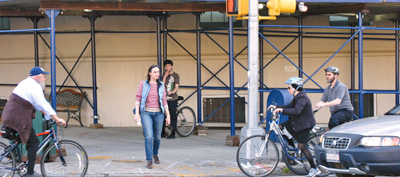Some 100 people came to the Prospect Park Residence on a recent Thursday evening to learn about the New York City Department of Transportation’s proposal for an unprotected, two-way bike lane on Plaza Streets East and West. At the meeting, jointly organized by Community Board 6 and 8’s transportation committees, one participant claimed that the primary mode of transportation in Brooklyn is cars, and that the city ought to facilitate rather than inhibit car movement.
The first part of that proposition is inaccurate; over the years, Census data have shown a clear majority of households in Brooklyn do not own cars.
 The second part of the statement is nonsense, ignoring major and obvious changes in transportation choices in recent years. It supposes that streets are like plumbing, not public space, and the city’s job is to make sure the plumbing flows freely regardless of what is sent down the pipe.
The second part of the statement is nonsense, ignoring major and obvious changes in transportation choices in recent years. It supposes that streets are like plumbing, not public space, and the city’s job is to make sure the plumbing flows freely regardless of what is sent down the pipe.
[pullquote]Cars, bicycles, and pedestrians are all vying for scarce street space.[/pullquote]The proposed bike lane would differ from Prospect Park West’s protected lane in that there would be no parked cars to separate it from the travel lanes. Cars would continue to park on Plaza Street as they do now. (The two full community boards will take up this proposal soon.) Discussion was lively, and even traditional bike-lane supporters had legitimate criticisms of what was on offer. If there was one point of consensus, it was that congestion is a serious problem — progress in how we all view the issue.
There are now more cars on the street, but bicycles have also become a significant part of the transportation mix. Contrary to what another participant at the meeting said, people do commute by bicycle and in increasing numbers. Stand on Bergen Street or the Manhattan Bridge and see for yourself. Sensing a demand to travel locally by bicycle, the city is about to launch a bike-share program similar to those in Washington, D.C., Montreal, and other large cities. And there are not only more cars and bicycles but also pedestrians vying for space. Streets will not and should not be made wider, but they must be safe for all users.
Moreover, part of the essence of urban life is that streets are indeed public space, and certainly not the exclusive preserve of motor vehicles. The streets in Brownstone Brooklyn and many other neighborhoods in the city were laid out before motor vehicles even existed. Today, our streets accommodate more cars than they did 50 years ago and many other users, too: trucks, buses, and bicycles. New development puts even more demands on our streets: more motorists, more delivery trucks, more people using “alternative” modes of transport (such as bicycles), and more pedestrians going from place to place.
How are the city and the community to balance all these demands for scarce street space? The city and the Metropolitan Transportation Authority should make it attractive for people to take public transportation or a bicycle, or go on their own two feet, to work, shopping, worship, or recreation. That means more transit service and a good, hard look at how to make transit service — especially bus routes — serve people better.
Street safety is also key, but in the end it’s the responsibility of street users. A concerted education campaign — focusing on the rules of the road for motorists, cyclists, and pedestrians — would go a long way. Some well-targeted enforcement is needed, but that can go only so far, even if police resources were unlimited.
There’s more. In 2007 the Park Slope Civic Council endorsed Mayor Bloomberg’s proposal for congestion pricing and insisted that other congestion mitigation measures be considered, such as residential permit parking. I believe the Civic Council will have the opportunity to consider these again in the near future.
This past January, the Civic Council and the Prospect Heights Neighborhood Development Council (PHNDC) held a forum on DOT’s initiative to institute neighborhood slow zones; a few weeks later, the Civic Council and Park Slope Neighbors submitted an application for a slow zone in Park Slope.
On March 31, some 50 residents from all over Brooklyn — hardly any of them “usual suspects” — took part in the BK Gateway Transportation Workshop, organized by Councilmember Letitia James and the Tri-State Transportation Campaign, and co-sponsored by the Civic Council, PHNDC, and others. The workshop’s breakout groups looked at pedestrian safety, bicycles, traffic, and mass transit, and came up with a well-informed look at traffic and transportation problems in Brownstone Brooklyn and beyond. Those of us at the workshop envision the “takeaway” to be a set of proposals to elected officials and a request for a comprehensive transportation study for Brooklyn.
Clearly there is a lot going on. The Civic Council is engaged in traffic, transportation, and safety issues on several fronts. We are looking to our members and the community at large to become informed about these issues and to join with us as we work on a community approach to them. We must have informed, comprehensive, and continuing input to government agencies and elected officials about these issues. These concerns affect everybody in our community, and I look forward to engaging the community constructively and productively.
Watch this space for news about future meetings to get this going. Be part of a community push for better transit, sensible transportation, and safe streets. Join the Park Slope Civic Council.
— Michael Cairl is president of the Civic Council.
Photo by David Herman
from the Spring 2012 Civic News

